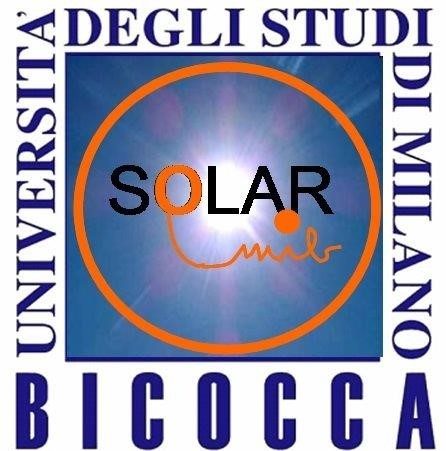Our group is involved in the design, synthesis, and characterization of organic and organometallic materials and devices for photoelectrochemical artificial photosynthesis, including n- and p-type dye-sensitized photoelectrochemical cells (n-DS-PEC and p-DS-PEC). PEC, pioneered by Fujishima and Honda in 1971, feature a photoanode and/or a photocathode, put in two half-cells, filled with a water based electrolyte, separated by a proton exchange membrane, and connected by an external circuit. The photoelectrodes are made of a network of disordered and inexpensive semiconducting nanoparticles (typically TiO2 for n-PEC and NiO for p-PEC) on a conductive glass, that in the case of DS-PEC are sensitized by a proper dye in order to improve the light-harvesting capability of the system. Together with the dye, also a proper catalyst is present, either dissolved in the electrolyte, anchored on the SC surface or as a part of a dye-catalyst dyad. Under irradiation, photons captured by the photoelectrode generate electron-hole pairs which separate at the surface of the nanoparticles. In a n-DS-PEC, electrons are injected and transported through the TiO2 layer while positive charges migrate via the catalyst for water oxidation. Electrons then reach the cathode (a Pt wire) via the external circuit, where protons are reduced to hydrogen. In a p-DS-PEC, electrons are used by the catalyst for the reduction of protons or of CO2, depending on the different catalyst used, while holes migrate to the cathode for water oxidation. In this way, it is possible to produce CO2-reduction-products such as methanol, formic acid, methane. Our work, in collaboration with university national and international partners, focuses on the synthesis of new materials photosensitizers with tailored properties and optimized performances thanks to the use of a fruitful combination of electron-rich and electron-poor (hetero)aromatic building units, a variety of structural design, and different symmetries and geometries.
Photosensitizers are then tested in MIB-SOLAR Center. Electrodes are prepared by screen-printing or spin-coating, then sensitized by dye and catalyst and tested in custom-made or commercially available PECs. DS-PECs undergo electrochemical measurements made with a (bi-)potentiostat illuminated by a solar simulator or by white sources, that can be equipped with UV (>420 nm) and IR (<800 nm) filters. The products of artificial photosynthesis reactions can be measured by means of a gas-chromatograph, an ionic chromatograph and a micro-oxygen sensor.
Research team: Prof. Alessandro Abbotto (Full Professor), Prof. Norberto Manfredi (Associate Professor), PhD Ottavia Bettucci (Assistant Professor).
- Decavoli, C.; Boldrini, C. L.; Faroldi, F.; Baldini, L.; Sansone, F.; Ranaudo, A.; Greco, C.; Cosentino, U.; Moro, G.; Manfredi, N.; Abbotto, A., “Calix[4]arene-Based Sensitizers for Host-Guest Supramolecular Dyads for Solar Energy Conversion in Photoelectrochemical Cells” Eur. J. Org. Chem. (2022), 34, e202200649.
- Decavoli, C.; Boldrini, C.L.; Trifiletti, V.; Luong, S.; Fenwick, O.; Manfredi, N.; Abbotto, A. “Dye–catalyst dyads for photoelectrochemical water oxidation based on metal-free sensitizers” RSC Adv. 2021, 11, 5311-5319.
- Boldrini, C.L.; Manfredi, N.; Montini, T.; Baldini, L.; Abbotto, A.; Fornasiero, P. “Calix[4]arene‐based molecular photosensitizers for sustainable hydrogen production and other solar applications“. Curr. Opin. Green Sustain. Chem. 2021, 100534.
- Decavoli, C.; Boldrini, C.L.; Manfredi, N.; Abbotto, A. “Molecular Organic Sensitizers for Photoelectrochemical Water Splitting” Eur. J. Inorg. Chem. 2020, 2020, 978-999.
- Manfredi, N.; Boldrini, C. L.; Abbotto, A., Organic Sensitizers for Photoanode Water Splitting in Dye-Sensitized Photoelectrochemical Cells. ChemElectroChem 2018, 5 (17), 2395-2402.
- Manfredi, N.; Monai, M.; Montini, T.; Peri, F.; De Angelis, F.; Fornasiero, P.; Abbotto, A. “Dye-sensitized Photocatalytic Hydrogen Generation: Efficiency Enhancement by Organic Photosensitizer – Co-Adsorbent Intermolecular Interaction” ACS Energy Letters, 2018, 3, 85-91.
- Manfredi, N.; Monai, M.; Montini, T.; Salamone, M.; Ruffo, R.; Fornasiero, P.; Abbotto, A. “Enhanced photocatalytic hydrogen generation using carbazole-based sensitizers” Sustainable Energy & Fuels, 2017, 1, 694 - 698
- Cecconi, B.; Manfredi, N.; Montini, T.; Fornasiero, P.; Abbotto, A. “Dye-Sensitized Solar Hydrogen Production: the Emerging Role of Metal-Free Organic Sensitizers” Eur. J. Org. Chem. 2016, 5194–5215.
- Manfredi, N.; Cecconi, B.; Calabrese, V.; Minotti, A.; Peri, F.; Ruffo, R.; Monai, M.; Romero-Ocaña, I.; Montini, T.; Fornasiero, P.; Abbotto, A. “Dye-sensitized photocatalytic hydrogen production: distinct activity in a glucose derivative of a phenothiazine dye”
Chem. Commun. 2016, 52, 6977 – 6980. - Cecconi, B.; Manfredi, N.; Ruffo, R.; Montini, T.; Romero-Ocaña, I.; Fornasiero, P.; Abbotto, A. “Tuning thiophene-based phenothiazines for stable photocatalytic H2 production” ChemSusChem 2015, 8, 4216-4228.

 '
'